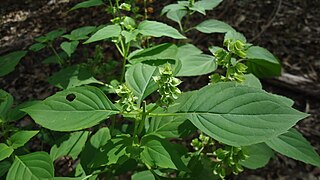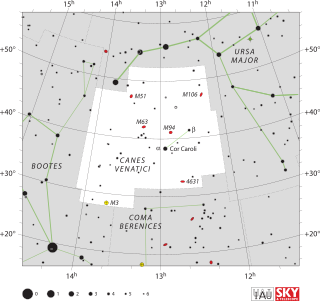
Canes Venatici is one of the 88 constellations designated by the International Astronomical Union (IAU). It is a small northern constellation that was created by Johannes Hevelius in the 17th century. Its name is Latin for 'hunting dogs', and the constellation is often depicted in illustrations as representing the dogs of Boötes the Herdsman, a neighboring constellation.

The Lamiaceae or Labiatae are a family of flowering plants commonly known as the mint or deadnettle or sage family. Many of the plants are aromatic in all parts and include widely used culinary herbs like basil, mint, rosemary, sage, savory, marjoram, oregano, hyssop, thyme, lavender, and perilla, as well as other medicinal herbs such as catnip, salvia, bee balm, wild dagga, and oriental motherwort. Some species are shrubs, trees, or, rarely, vines. Many members of the family are widely cultivated, not only for their aromatic qualities, but also their ease of cultivation, since they are readily propagated by stem cuttings. Besides those grown for their edible leaves, some are grown for decorative foliage. Others are grown for seed, such as Salvia hispanica (chia), or for their edible tubers, such as Plectranthus edulis, Plectranthus esculentus, Plectranthus rotundifolius, and Stachys affinis. Many are also grown ornamentally, notably coleus, Plectranthus, and many Salvia species and hybrids.
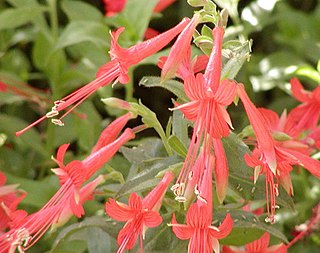
Epilobium canum, also known as California fuchsia or Zauschneria, is a species of willowherb in the evening primrose family (Onagraceae). It is native to dry slopes and in chaparral of western North America, especially California. It is a perennial plant, notable for the profusion of bright scarlet flowers in late summer and autumn.

The Cor Caroli system is a binary star designated Alpha Canum Venaticorum or α Canum Venaticorum. The International Astronomical Union uses the name "Cor Caroli" specifically for the brighter star of the binary. Alpha Canum Venaticorum is the brightest point of light in the northern constellation of Canes Venatici.

Helianthemum, known as rock rose, sunrose, rushrose, or frostweed, is a genus of about 110 species of flowering plants in the family Cistaceae. They are widely distributed throughout the Northern Hemisphere, especially in the Mediterranean.
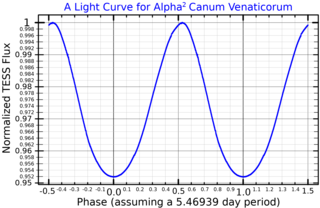
An Alpha2 Canum Venaticorum variable is a type of variable star. These stars are chemically peculiar main sequence stars of spectral class B8p to A7p. They have strong magnetic fields and strong silicon, strontium, or chromium spectral lines. Their brightness typically varies by 0.01 to 0.1 magnitudes over the course of 0.5 to 160 days.
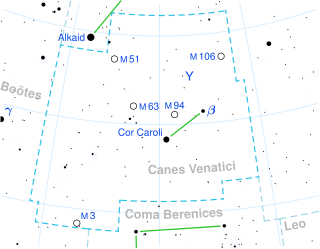
Beta Canum Venaticorum, also named Chara, is a G-type main-sequence star in the northern constellation of Canes Venatici. At an apparent visual magnitude of 4.25, it is the second-brightest star in the constellation. Based upon an annual parallax shift of 118 mas, this star is 27.6 light-years distant from the Sun.
5 Canum Venaticorum is a probable binary star system in the northern constellation of Canes Venatici, located about 375 light years from the Sun. It is visible to the naked eye as a faint, yellow-hued star with an apparent visual magnitude of +4.77. The system is moving closer to the Earth with a heliocentric radial velocity of −14 km/s.
21 Canum Venaticorum is a single variable star in the northern constellation of Canes Venatici, located 277 light years away from the Sun. This object has the variable star designation BK Canum Venaticorum; 21 Canum Venaticorum is the Flamsteed designation. It is visible to the naked eye as a faint white-hued star with a baseline apparent visual magnitude of +5.14.

Gyalopion canum, commonly known as the Western hooknose snake, is a species of small colubrid snake endemic to the deserts of the United States and Mexico. It is sometimes referred to as the Chihuahuan hook-nosed snake because it is commonly found in the Chihuahuan Desert.
NVC community CG1 is one of the calcicolous grassland communities in the British National Vegetation Classification system. It is one of three short-sward communities associated with heavy grazing, within the lowland calcicolous grassland group, and is regarded as the south-west coastal counterpart of "typical" chalk grassland.
Parafomoria helianthemella is a moth of the family Nepticulidae. It is found in central and southern Europe, including Germany, south-eastern Poland, the Czech Republic, Slovakia, Hungary, Austria, Switzerland, northern Italy, France and Bulgaria.
Adscita capitalis is a moth of the family Zygaenidae. It is found in North Macedonia, Greece and Turkey.
Emil Erwin Alfred Ritter von Janchen-Michel was an Austrian botanist.
Californian fuchsia or California fuchsia may refer to one of two plant species:
Hoary rock-rose is a common name for several plants and may refer to:

Lamioideae is a subfamily of plants in the family Lamiaceae.

RS Canum Venaticorum is a binary star system in the northern constellation of Canes Venatici. It serves as the prototype to the class of RS Canum Venaticorum variables. The peak apparent visual magnitude of this system is below the level needed to observe it with the naked eye. It is located at a distance of approximately 443 light years from the Sun based on parallax, but is drifting closer with a net radial velocity of −14 km/s. Olin J. Eggen (1991) included this system as a member of the IC 2391 supercluster, but it was later excluded.




